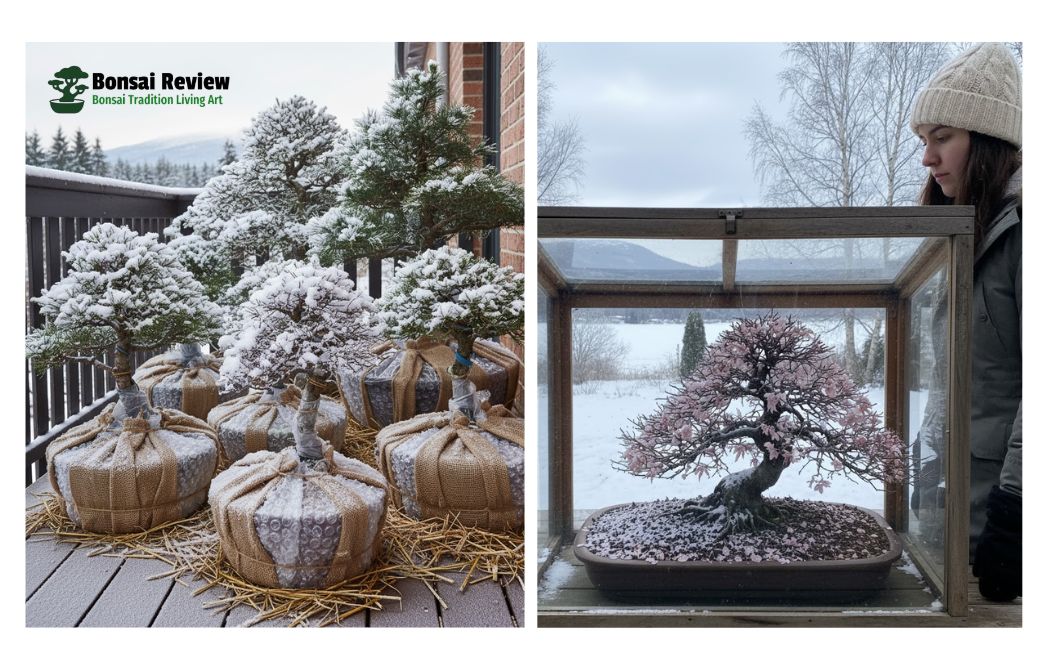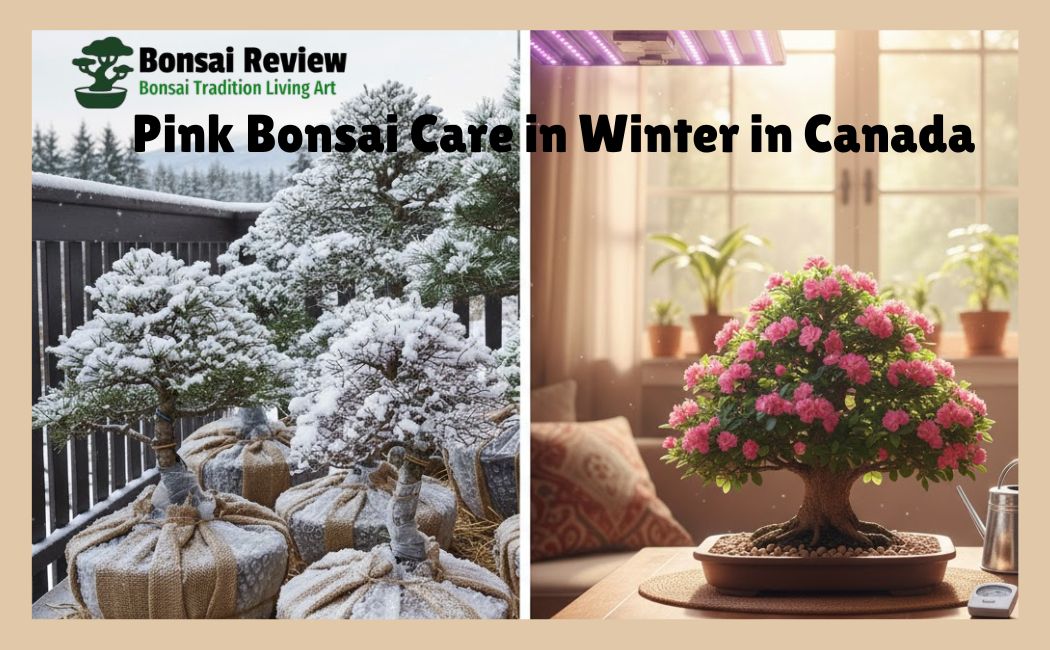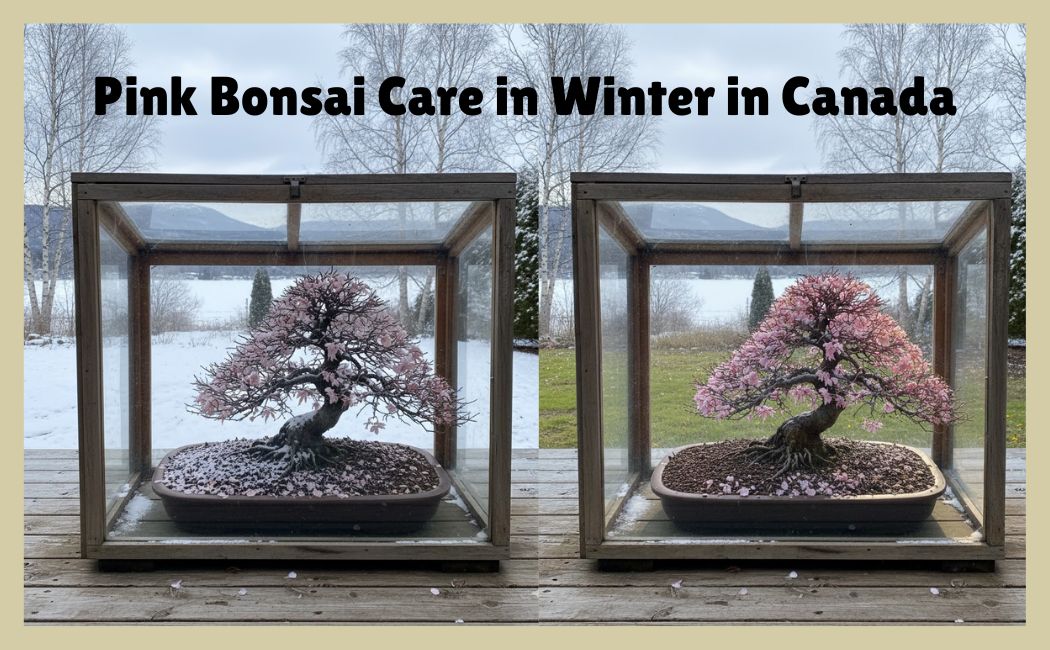For Pink Bonsai Care Winter Canada, a key decision is identifying if it’s a cold-hardy or tropical species. Cold-hardy species need to stay outdoors in a protected location, like a cold frame or unheated garage, to remain dormant while being shielded from wind and freeze-thaw cycles. Tropical species, like Ficus or Jade plant, must be brought indoors before the first frost and kept above
For pink bonsai in Canadian winters, a dwarf tree species known as a pink-flowered acacia bonsai or a pink-flowered serissa bonsai is the most likely answer.
Since Serissa is a tropical species, it must be brought indoors before the first frost. Since pink-flowered acacias are usually treated like other acacias, and if they are temperate, they can be kept outdoors in a sheltered location.
For pink-flowered acacia bonsai in Canada, they should be kept outdoors in a sheltered spot, protected from wind and direct sun.
When bringing indoors, the key is to not overwater and to keep the plant in a cool, but not frozen environment, with 40-50°F being ideal. Also, protected pink bonsai care winter Canada from any strong winds that could cause it to dry out quickly.
Pink Bonsai Care Winter Canada: Keep Your Blossoms Safe from Frost.
For winter outdoor care, protect your pink bonsai from wind and temperature fluctuations by grouping them and burying the pots in mulch or placing them in a cold frame or unheated garage. Reduce watering to only when the soil is dry, do not fertilize, and keep the tree dormant to prevent new, vulnerable growth from appearing
Outdoor Pink Bonsai Care Winter Canada:
- Protect from wind: Keep the tree in a sheltered spot, away from strong winds, which can dry it out.
- Provide light: Give the tree a spot with good sunlight, but avoid direct sun on frozen soil.
- Keep soil damp: Check the soil every few weeks and water as needed to keep it evenly damp, but not waterlogged.
- Monitor temperature: Avoid prolonged periods below freezing, as this can damage the tree.
- Use insulation: Wrap the pots with bubble wrap or a bedsheet to insulate the roots from the cold.
Indoor Pink Bonsai Care Winter Canada:
For indoor pink bonsai care in Canada, move tropical species inside when temperatures drop below 10 °C, providing a bright, south-facing window and high humidity with a humidity tray or misting. Water when the topsoil feels slightly dry, avoid direct contact with heat vents, and reduce fertilization during winter.

For All-season Pink Bonsai Care Winter Canada:
- Ficus is more forgiving of lower humidity than other tropicals. Needs frequent pruning to maintain shape and size.
- Schefflera tolerates a wide range of conditions and can be easily pruned. It can be susceptible to spider mites in dry indoor environments.
- Serissa (Snow Rose) produces small, white, star-shaped flowers, providing aesthetic interest. Snow Rose can be sensitive to changes in location or watering, causing leaves to drop.
For year-round placement for Pink Bonsai Care Winter Canada:
- Bright, indirect sunlight: Place the bonsai in a south-facing window or use grow lights for 10-12 hours a day, as stated in Bonsai beginner’s design.
- Humidity tray: Place the pot on a tray filled with pebbles and water to increase humidity around the plant.
- Avoid heat vents: Keep the bonsai away from radiators, heating vents, or other heat sources that can dry out the soil and foliage
- Bring indoors before first frost: Move the plant indoors before the first frost hits, around the time overnight temperatures drop to 50°C
For indoor tropical care in Canada:
- Watering: Check the soil daily and water thoroughly when the top layer feels slightly dry, but do not let the plant sit in water.
- Humidity: Use a humidity tray and/or mist the leaves daily to maintain high humidity levels.
- Pruning: Prune the new shoots to maintain the desired shape and size.
- Fertilizing: Use liquid fertilizer every two weeks during the growing season and once a month during winter with a reduced amount.
- Repotting: Repot every two years in the early spring to provide a fresh start for the plant.
- Pest control: Check the tree for pests before bringing it inside and consider using an insecticide if necessary.
However, the easiest solution for tropical bonsai is to bring them indoors for the winter months. Place the trees in a bright, warm spot and continue to water when the soil begins to dry out. Pink Bonsai Care Winter Canada: Avoid placing the trees near heating vents that can dry out the bonsai quickly.
How to Keep Your Pink Bonsai Alive and Blooming in Canada’s Winter?
Pink Bonsai Care Winter Canada can be scary. The freezing air, dry rooms, and long nights make it hard to know where your tiny tree belongs.
To keep a pink bonsai alive and blooming in a Canadian winter, you must identify if it is a tropical or cold-hardy species. Tropical bonsai need to be brought indoors to a warm, bright location with high humidity.
In contrast, cold-hardy bonsai must be protected from extreme cold by placing them in a cold frame, greenhouse, or unheated garage to allow them to remain cool but safe from deep freezes. Both types require careful monitoring of watering to prevent overwatering and root rot
You see your pink blooms fade, the leaves drop, and you start to worry, Is my bonsai dying or just sleeping? Don’t panic. Your tree is not giving up; it’s just asking for the right winter plan.
If you have a cold-hardy bonsai like Azalea, Cherry Blossom, or Japanese Maple (Acer palmatum), your tree needs a quiet dormancy in the cold. But if it’s a tropical type like Bougainvillea, Serissa (Snow Rose), or Ficus, it needs warm air, bright light, and extra humidity indoors. The trick is knowing which kind you have and matching its needs to your home or garden.
How to protect your bonsai from frost, manage temperature control, use mulch insulation, set up a cold frame or unheated garage, balance soil moisture, and prevent spider mites or aphids. You’ll have a simple winter plan that helps your pink bonsai rest safely and bloom again when spring returns to Canada.

Understanding Your Dwarf Plants Type Pink Bonsai Care Winter Canada
Before you start winter care, you need to know what kind of pink bonsai you have. Every bonsai reacts to Canada’s cold differently. Some trees love the chill. Others can die if you leave them outside too long.
If your bonsai is a cold-hardy type like Azalea bonsai, Cherry Blossom bonsai, or Japanese Maple (Acer palmatum), it’s used to winter. These trees come from cooler climates and need a period of dormancy to stay healthy. During this rest time, the tree slows down. The leaves may fall, but the roots keep working under the soil.
If your tree is tropical, like a Bougainvillea bonsai, Serissa bonsai (Snow Rose), or Ficus bonsai, it can’t survive frost. These types love warmth and bright light. In Canada’s cold months, they belong indoors, where you can control temperature and humidity more easily.
To do you winterize a pink bonsai tree in Canada your pink bonsai, first identify whether it’s cold-hardy (like Azalea, Cherry Blossom, Japanese Maple/Acer palmatum) or tropical (like Bougainvillea, Serissa/Snow Rose, Ficus).
Cold-hardy bonsai should stay outdoors in a cold frame, unheated garage, or sheltered spot with mulch insulation around the root ball.
Tropical bonsai need to move indoors before the first frost, with stable temperature, light, and humidity. Check soil moisture regularly and protect from freeze-thaw cycles.
Can Pink Bonsai Stay Outside in a Canadian Winter?
Yes, but only if it’s the right kind. Cold-hardy pink bonsai trees like Azalea, Cherry Blossom, and Japanese Maple (Acer palmatum) can handle Canada’s chill with a little help from you. These trees need winter’s cold to rest, but they still need protection from harsh wind exposure and freeze-thaw cycles that can damage their roots.
The best place for them is a cold frame, an unheated garage, or a sheltered balcony corner. These spots let your bonsai stay cool enough for dormancy without facing direct frost.
Wrap the pot or root ball with mulch insulation to keep the soil stable. Check soil moisture once a week, not too wet, not too dry. The soil should feel just damp to the touch.
If snow covers your bonsai, don’t rush to remove it. A light snow layer can actually act as natural insulation. But if ice starts forming on the soil, move the plant to a slightly warmer area to prevent root damage.
By protecting your cold-hardy bonsai from strong winds and sudden temperature drops, you help it rest peacefully through the long Canadian winter, ready to wake up and bloom again in spring.
To find out your bonsai type, check its tag, ask at a bonsai nursery, or look up its name online. Once you know, you can follow the right winter care steps for that type. It’s the first key to keeping your pink bonsai safe until spring.
How Do You Keep a Pink Bonsai Alive Indoors All Winter?
If your pink bonsai is a tropical type like Bougainvillea, Serissa (Snow Rose), or Ficus, it must move indoors before the first frost hits. These trees can’t handle freezing temperatures, but they’ll thrive inside your warm home when you create the right setup.
Place your bonsai near a south-facing window where it can soak up bright light for at least six hours a day. If your home doesn’t get enough natural sunlight, use an indoor grow light to keep it happy. The light keeps its leaves strong and helps it keep a steady rhythm, even during Canada’s dark winter days.
Indoor air often gets too dry from heaters, which can stress your bonsai. Set up a humidity tray or a small humidifier nearby to keep humidity levels balanced. The tree’s leaves will thank you. Keep the temperature between 70°F and 80°F (21°C–27°C). Steady warmth helps pink bonsai care winter Canada to avoid shock.
Watch for tiny pests like spider mites and aphids, which often show up when the air is dry. If you see them, gently wipe the leaves with a damp cloth or spray them with clean water.
Your goal is to give your tropical bonsai the same comfort it would have in a warm, sunny climate. With just the right mix of light, warmth, and moisture, your pink bonsai will stay healthy all winter and reward you with lush new growth when spring comes back.

What Are the Common Winter Mistakes You Might Be Making?
When winter hits, even the most loving bonsai owners can make small mistakes that cause big trouble for their trees. If your pink bonsai starts to look dull, drop leaves, or stop growing, it’s often a sign of one of these common winter care slips.
1. Bringing outdoor bonsai into warm rooms too early.
Cold-hardy pink bonsai, like Azalea, Cherry Blossom, or Maple (Acer palmatum), need dormancy. When you bring them inside a warm house, they wake up too soon, and that weakens them. Instead, keep them in an unheated garage, cold frame, or sheltered porch where temps stay around 33°F to 40°F (0.5°C–4.5°C).
2. Letting the soil dry out completely.
Even when dormant, bonsai roots can’t survive total dryness. You don’t need to water often, maybe every few weeks, but check the soil. When it feels dry halfway down, give a gentle soak.
3. Exposing the tree to harsh wind or frost.
Winter winds are a silent killer. They strip away moisture and cause freeze-thaw stress, cracking roots and bark. Use mulch, bubble wrap, or burlap around the pot to shield it. Place your bonsai where the wind can’t reach directly.
4. Ignoring pest buildup indoors.
Warm, dry rooms are heaven for spider mites, aphids, and scale insects. Inspect leaves weekly. If you spot any, rinse them off, and keep humidity steady. Dry air invites trouble.
5. Forgetting about light.
Both indoor and outdoor bonsai need light, even in winter. Without Pink Bonsai Care Winter Canada, your bonsai becomes leggy and pale. Position indoor ones near a south window or use a grow light for 6 hours daily.
Every mistake is easy to fix once you know the cause. When you understand how your bonsai reacts to the cold, you stop guessing and start growing a healthy, pink-blooming tree that wakes up strong every spring.
How Do You Wake Up Your Pink Bonsai Safely in Spring?
When winter ends and the snow starts to melt, your pink bonsai begins to stir from dormancy. But waking it up too fast can shock Pink Bonsai Care Winter Canada, especially in Canada, where late frost can still sneak up. So, you need to help your tree transition gently from its cold rest to active growth.
Start by removing winter protection slowly. If your bonsai was in a cold frame or unheated garage, open it during the day for fresh air but close it again at night for a few weeks. This helps your tree adjust to changing light and temperature without sudden stress.
Once nighttime temperatures stay safely above 40°F (4°C), move your bonsai outdoors to a bright but sheltered spot. Avoid direct sunlight for the first few days your tree’s tender leaves can burn easily after months in the shade.
Check the soil moisture often. Dormant roots now need more water as they wake up and start absorbing nutrients again. Begin feeding your bonsai with a balanced fertilizer like 10-10-10 or organic bonsai feed to rebuild Pink Bonsai Care Winter Canada strength after winter.
Trim away any dead or weak branches, but don’t rush heavy pruning yet. Let new buds appear first; they show which parts are alive and healthy.
If you cared for your bonsai correctly through the winter, this stage will feel magical. You’ll see tiny pink buds, soft green shoots, and your tree will begin its new cycle proof that your winter care worked.
Conclusion: Your Pink Bonsai Can Thrive Through the Canadian Winter
Taking your pink bonsai care winter Canada, doesn’t have to feel scary. Your tree is a cold-hardy Azalea, Cherry Blossom, or Japanese Maple (Acer palmatum), or a tropical Bougainvillea, Serissa (Snow Rose), or Ficus; understanding its needs is the key.
By protecting cold-hardy trees with a cold frame, unheated garage, or mulch insulation, and giving tropical types the right light, warmth, and humidity indoors, you ensure your bonsai stays healthy all season.
Keep an eye on soil moisture, watch for pests like spider mites or aphids, and respect each tree’s natural dormancy.
When spring comes, your pink bonsai will reward your care with fresh growth and vibrant blooms, proof that your careful winter plan worked.
With the right preparation, patience, and understanding, your bonsai can survive Canada’s cold months and thrive year after year, bright, beautiful, and full of life.
Most relevant article: Which Bonsai Is Best for Indoors? 7 Are Practically Unkillable!
FAQs: Pink Bonsai Care Winter Canada: Tips for Cold-Hardy and Tropical Trees.
1. How to protect bonsai in winter?
Overwintering Bonsai trees requires special winter care. Make sure to place your trees in a spot without too much wind. In milder climates, with temperatures of around 25 °F (-4 °C) at night, a cold frame won’t be required. Still recommend protecting your trees from strong winds and placing your trees on the ground. This helps to prevent sudden temperature drops.
2. Can bonsai trees survive winter indoors in Canada?
Yes, tropical bonsai like Serissa (Snow Rose), Bougainvillea, and Ficus can survive indoors if you provide bright light (sunny window or grow light), stable temperature (70–80°F / 21–27°C), and maintain humidity with a tray or humidifier. Watch for pests like spider mites or aphids, which thrive in dry indoor air.
3. How do you take care of a Maple bonsai during winter?
Cold-hardy maples, such as Japanese Maple (Acer palmatum) or Red Maple bonsai, should stay outdoors in a protected location to remain in dormancy. Keep the root ball insulated, avoid direct wind, and water sparingly when the soil feels dry. Never bring them indoors too early, as warmth can wake them from dormancy and harm the tree.
4. How often should you water a bonsai in winter?
Water cold-hardy bonsai only when the soil starts to feel dry, usually every few weeks. Tropical bonsai indoors need more frequent checks; keep the soil lightly moist but not soggy. Avoid letting roots sit in standing water to prevent root rot.
5. What temperature is safe for bonsai in the Canadian winter?
Cold-hardy bonsai: 33–40°F (0.5–4.5°C) for dormancy. Tropical bonsai: 70–80°F (21–27°C) indoors, avoiding sudden drafts or temperature drops.
6. Can Azalea or Cherry Blossom bonsai survive snow?
Yes, light snow can act as natural insulation for cold-hardy bonsai, protecting the roots from freezing. However, avoid ice forming on the soil surface and protect the tree from strong wind exposure and heavy frost.
7. What are the common winter pests for indoor bonsai?
In warm, dry indoor conditions, watch for spider mites, aphids, and scale insects. Inspect leaves weekly, wipe with a damp cloth, and maintain proper humidity to prevent infestations.
8. Should you fertilize bonsai during winter?
No, avoid heavy fertilizing while the tree is dormant. For tropical bonsai indoors, you may give very light feeding if the tree shows new growth, but most bonsai do not need fertilizer until spring revival.
9. Can Juniper bonsai survive the Canadian winter?
Yes, Juniper bonsai is a cold-hardy species. Keep it outdoors in a sheltered location, protect the root ball, and water sparingly. Pink Bonsai Care Winter Canada: Avoid sudden temperature swings that can stress the tree.
10. How do you know if your bonsai is awake from dormancy?
Look for new buds or soft green shoots emerging from branches. This indicates the tree is ready for spring revival, and you can gradually increase water, sunlight, and start light pruning.